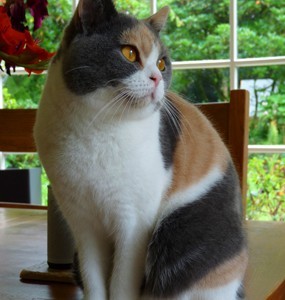Background
If the American Shorthair is a true American cat, the British Shorthair is a true British cat!
Brought to Britain by the Romans over 2,000 years ago, the British Shorthair has come a long way since its early days as a mouser and ratter. Over the years, the British Shorthair interbred with cats native to Britain, and later with Persians (which contributed to their thick coat). Eventually, the breed became more popular for its placid and loyal personality than its hunting abilities.
 While the popularity of the British Shorthair declined some during the 1940s – food shortages during WWII also almost led to the breed’s extinction – the breeding program was revitalized during the post-war period. The breed was officially recognized in the United States in the 1970s, and today the British Shorthair is one of the most popular breeds in Europe and America.
While the popularity of the British Shorthair declined some during the 1940s – food shortages during WWII also almost led to the breed’s extinction – the breeding program was revitalized during the post-war period. The breed was officially recognized in the United States in the 1970s, and today the British Shorthair is one of the most popular breeds in Europe and America.
Cat Facts
Here are some more interesting facts about the American Shorthair:
- The Cheshire Cat from Lewis Carroll’s Alice’s Adventures in Wonderland is a British Shorthair.
- The British Shorthair almost went extinct during World War II due to food shortages.
- It takes a British Shorthair 3-5 years to reach physical maturity, meaning they look great a lot longer than other cats. In addition, their life expectancy is greater than most breeds – the British Shorthair often lives in excess of 20 years.
- Weight: 9-16 pounds
- Lifespan: 14-20 years
What are they like?
Displaying a reserve typical of the British, the British Shorthair is an even-tempered, easy-going cat that could even be considered shy. Loyal and loving, the British Shorthair will bond with the whole family rather than just a singlespecial person. They are independent, adaptable, and understated and while they don’t need loads of affection, but they are also just as happy sitting on your lap being stroked.
The British Shorthair greets visitors and other pets with a warm welcome, and he is a very smart breed of cat that learns quickly. You shouldn’t be surprised if your British Shorthair learns to open a door or a cabinet with ease!
As breeds go, the British Shorthair is one of the healthiest. He is only prone to a couple hereditary health problems:
- Hypertrophic cardiomyopathy (HCM), a form of heart disease
- Hemophilia B, a bleeding disorder, for which there has been a DNA test established to help breeders identify carriers and affected cats
Right for you?
The British Shorthair is a great breed of cat for people who have the time to spend with one. Here are some things to consider if you’re thinking about welcoming one into your home:
- A lazy cat equals a fat cat! Some British Shorthairs like to lounge around, and that makes them prone to obesity and the health problems that come with being overweight.
- Be patient. It takes the British Shorthair up to five years to attain full physical and mental maturity. It might take a little more work to housetrain a British Shorthair, but his long life expectancy (20 years) means he’ll be with you for a long time.
- Grooming is really easy. The fur of British Shorthairs is short, close-lying, and lustrous, and it is dense enough to protect against the elements. A weekly combing is usually all that is necessary to keep the fur clean and healthy.
If you have any questions or concerns, you should always visit or call your veterinarian – they are your best resource to ensure the health and well-being of your pets.
